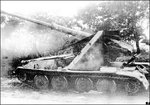parsifal
Colonel
One thing I should clarify about Germany. her principal weakness was not a lack of industrial potential, so much as inadequate manpower. Germany did not have the manpower reserves that were available to the Russians, and this did influence he production choices as the war progressed.
Shortrounds point about german perceptions on armoured warfare are well made, in my opinion. This was in no small measure due to the German early encounters with the Russian advanced armour designs in '41-2, principally the T-34 and KV-1s. Men like guderian could see that in the hands of an experienced crew, a T-34 or a KV-1 could get the better of a mkIII or an early Mk IV. Their reaction was to construct the heavy tanks like the tiger and panther
Whilst I believe the Tiger (both mks I and II) were a profligate waste of resources, the Panther was less so.....it took half the resources to build compared to a Tiger, and was more than adequate to deal with most armoured threats then in place. My opnion is that the heavy tank should have been solely built around the Panther, with no Mk IV, and supplemented by an increased output of SGIII s. It cost roughly 2/3 the cost of a Mk IV to build a SGIII, and the Stug was about as effective defensively as the bigger German tanks. I would also have increased the production of towed ATGs, concentrating on the 75mm calibre (forget the 88s), and not wasted time putting out the Luftwaffe field divs, or the SS formations to pay for that effort....but then i am digressing badly I guess
Shortrounds point about german perceptions on armoured warfare are well made, in my opinion. This was in no small measure due to the German early encounters with the Russian advanced armour designs in '41-2, principally the T-34 and KV-1s. Men like guderian could see that in the hands of an experienced crew, a T-34 or a KV-1 could get the better of a mkIII or an early Mk IV. Their reaction was to construct the heavy tanks like the tiger and panther
Whilst I believe the Tiger (both mks I and II) were a profligate waste of resources, the Panther was less so.....it took half the resources to build compared to a Tiger, and was more than adequate to deal with most armoured threats then in place. My opnion is that the heavy tank should have been solely built around the Panther, with no Mk IV, and supplemented by an increased output of SGIII s. It cost roughly 2/3 the cost of a Mk IV to build a SGIII, and the Stug was about as effective defensively as the bigger German tanks. I would also have increased the production of towed ATGs, concentrating on the 75mm calibre (forget the 88s), and not wasted time putting out the Luftwaffe field divs, or the SS formations to pay for that effort....but then i am digressing badly I guess

